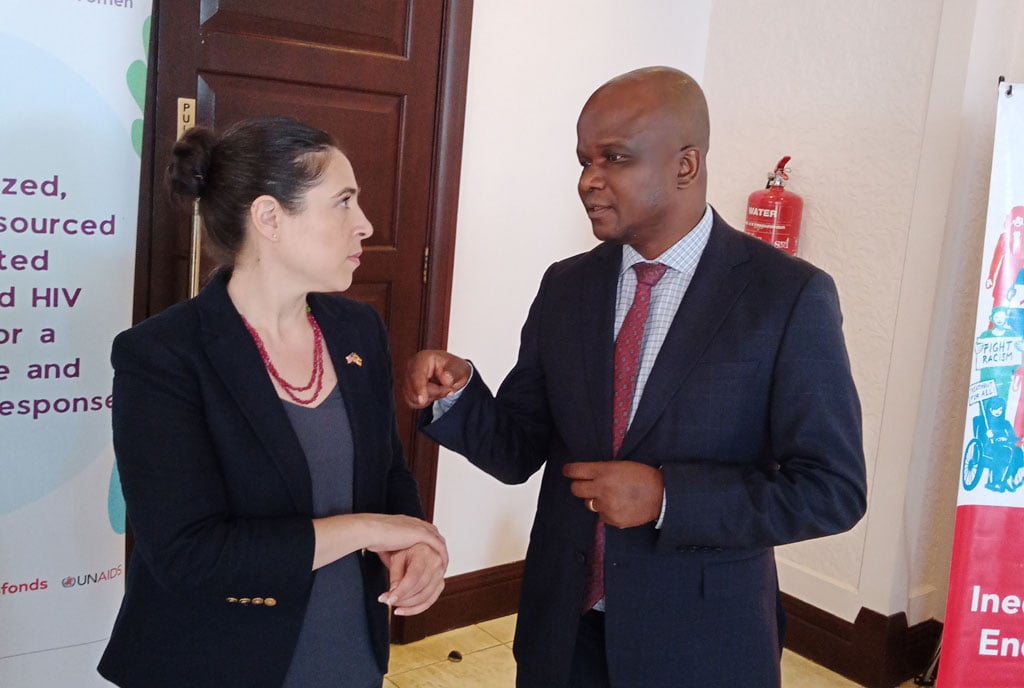Prime
70% new HIV cases are in young girls - report

The Director General of Uganda Aids Commission, Dr Nelson Musoba, with Ms Mary Bogman, the country coordinator of PEPFAR, at the launch of HIV prevention manifesto on September 8, 2023 in Wakiso District. PHOTO/TONNY ABET
What you need to know:
- This has been attributed to, among others, inadequate information about prevention, gender-based violence and rape.
More than two-thirds of the 30,000 new HIV infections reported among women last year occurred in the ages 15 to 25, the Uganda Aids Commission (UAC) has revealed.
Dr Nelson Musoba, the UAC Director General, said in an interview on Friday that women continue to be disproportionately affected by the scourge.
“We have looked at our data and observed that the women are more affected than the men. In our most recent data for 2022, the HIV prevalence was 5.1 percent (the national average), but when you break it down, for women, it was 6.5 percent and for men, it was 3.9 percent. So, prevalence among women is much higher,” he said.
He added: “But also, out of the [total] 52,000 new infections last year, women accounted for 30,000. And 70 percent of the new infections among women, were adolescent girls and young women between the age of 15 and 25.”
Dr Musoba blamed the high infection rates among young women on inadequate information about prevention and stigma while accessing services in health facilities as well as gender-based violence and rape.
“Because of a combination of factors, inequitable distribution of wealth and income, our cultural aspects, young women are more vulnerable [to HIV infection]. The solution is about increasing communication –ensuring that we break down communication that we communicate to young people through their peers,” he said.
The UAC director general also said they are considering using social media as a forum and working with the Ministry of Health to ensure young people have access to prevention services.
“Corners for handling young people should be there [in health facilities], health workers should be trained to handle young people and there should be programmes for young people,” Dr Musoba said.
He was speaking on the side lines of the launch of the HIV prevention choice manifesto at Lake Victoria Serena Golf Resort in Wakiso on Friday last week, a new campaign by feminists in Africa which seeks to increase access to virus prevention tools.
The event attracted delegates from different countries, with Ms Winnie Byanyima, the Executive Director of UNAIDS, the Joint United Nations Programme on HIV/Aids, as the chief guest.
Ms Byanyima, in her remarks, asked the government to embrace strategies and new technologies that are proven to reduce HIV infections.
“We have a young generation who didn’t see people dying of Aids because now we have 1.2 million people who are on treatment. So young people think that there is no HIV. So, we need to renew the prevention messaging so that young people know about their bodies, about the risks in puberty,” she said.
“Some of this comes through giving education in schools. That’s why we are advocating for sexuality education in schools. And there isn’t an uptake here in Uganda because of resistance by traditional conservative people. But it is vital that we give the young people right information to protect themselves,” she added
Ms Lillian Mworeko, the regional coordinator for the International Community of Women Living with HIV East Africa (ICWEA), explained that the prevention choice manifesto is the demand by women and girls in Africa that they require more options and choices to prevent HIV infection.
“And it is premised on the fact that we continue to see young women and girls getting infected with HIV, particularly in Africa and yet there are tools that are available that they can use to prevent these new HIV infections,” she said.
“One of the new tools for prevention is dapivirine vaginal ring, which has been approved. But unfortunately, countries in Africa are very slow to get these tools to the women,” she added. The other prevention tool the women want is cabotegravir, a drug which is used for short-term prevention of HIV infection in certain adults and adolescents 12 years of age or older. It has been commended by the World Health Organisation.
The UNAIDS executive director said they are also pushing companies to share health technologies with manufacturers in low-income countries for affordability purposes.




